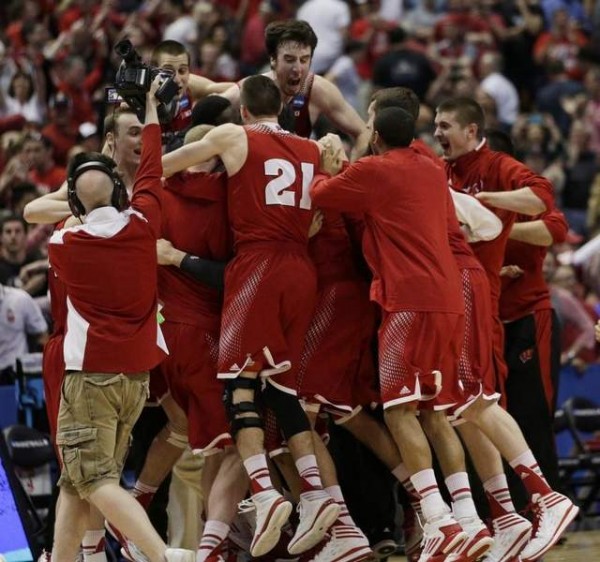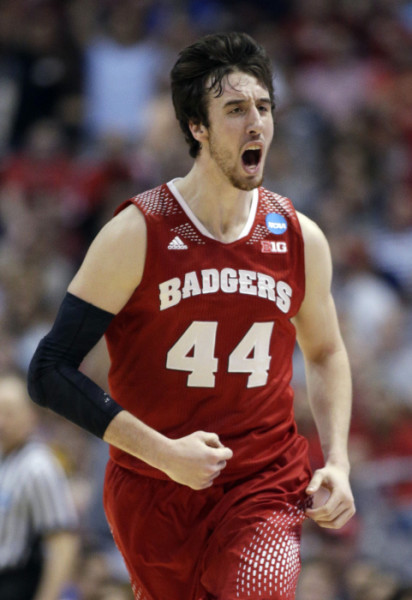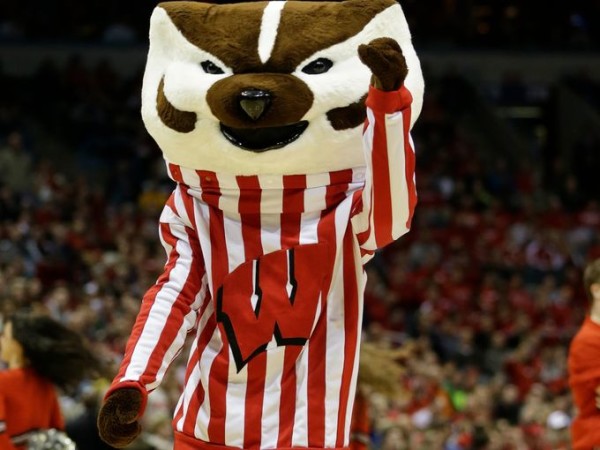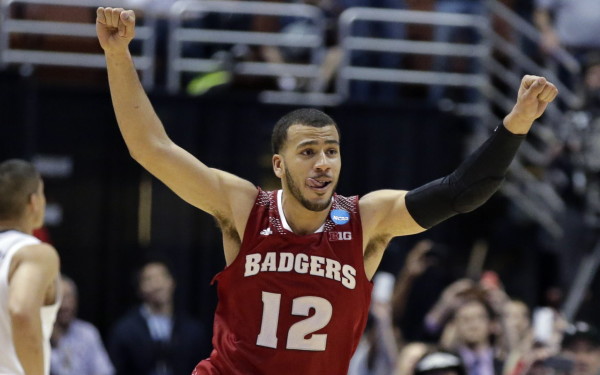Final Four Previews In-Depth: Wisconsin Badgers
Posted by Andrew Murawa on April 3rd, 2014As part of our ongoing NCAA Tournament coverage, RTC is unveiling a detailed look at each of the Final Four teams throughout the week. Kentucky and UConn have already released. Today: Wisconsin.
In the days between Selection Sunday and the actual start of the NCAA Tournament, Wisconsin flew under the radar. In a West Region lacking the punch of, say, the loaded Midwest Region, the #2 seed was picked by just 20 percent of ESPN.com‘s bracket entrants to advance to the Final Four, while nearly half of those brackets instead favoring Arizona. But after riding the a little home-cooking through the Milwaukee pod in the first weekend then taking care of business in Anaheim against two of the hottest teams in the nation (Baylor and Arizona), it is the Badgers that are left standing, delivering the first Division I Final Four in Bo Ryan‘s successful career.

Wisconsin Earned Its Third Final Four Appearance With A Dramatic Win Over Arizona On Saturday (Jae C. Hong, AP Photo)
Pre-NCAA Tournament Capsule. Coming into the season, expectations were somewhat measured for the Badgers. With last year’s frontcourt stalwarts Ryan Evans, Jarred Berggren and Mike Bruesewitz all having used up their collegiate eligibility, Ryan was going to have to rely more on his veteran backcourt of sophomore Sam Dekker and some additional to-be-determined frontcourt players. Very early in the season, we got a big hint as to which of those candidates had the most potential, as junior seven-footer Frank Kaminsky, after scoring only 10 points in his first two games, dropped 43 points on just 19 field goal attempts in the Badgers’ fourth game of the season. From that point forward, Kaminsky regularly scored in double-figures for Wisconsin, and he did so in a highly-efficient manner. Meanwhile, in fewer minutes, freshman big man Nigel Hayes was also establishing himself as a force to be reckoned with, turning a preseason question mark into a serious strength for Ryan’s club. With the backcourt of Traevon Jackson, Ben Brust and Josh Gasser locked into their roles and Dekker taking the obvious next step in his development, Wisconsin got off to a great start, winning its first 16 games of the season and jumping into the national top five. Playing with more pace and offensive punch than they had in previous years under Ryan, the Badgers were recognized roundly as maybe the coach’s best bet at a Final Four.
And then came the unthinkable. For a program built on defensive stinginess, the Badgers allowed 1.13 points per possession in a series of five losses over the course of six games as January melted into February. Teams that were on the outside looking in on Selection Sunday – Indiana, Minnesota, Northwestern – were not only scoring in heaps on the Badgers, but they were getting the necessary stops on the other end too. College basketball fans were left to ponder exactly what they thought they knew about the Badgers, and most seemed to default back to remembering the 2013 NCAA loss to Mississippi or the 2011 loss to Butler and write the Badgers off, even as they rebounded to reel off eight straight wins afterward. But a regular season-ending loss to Nebraska and a largely noncompetitive loss to Michigan State in the Big Ten Tournament sent Wisconsin into the NCAA Tournament, even with a gaudy two-seed, as something of an afterthought.
How They Got Here. For about the first 16 minutes of the Badgers’ NCAA Tournament, they looked very average, taking just a two-point lead to the first half under-four media timeout against American, the first of three fairly slow starts to their NCAA games. The Badgers quickly turned things around against American and outscored the #15 seed by a margin of 53-15 the rest of the way, with Jackson and Brust combining for 35 points on 17 field goal attempts. Against an upset-minded Oregon squad in the round of 32, Wisconsin found itself in quite a bit more trouble, down 12 points down to the Ducks at the half. However, in the second half, the Badgers made getting the ball inside first and foremost a priority. Their first six points of the second half were all layups, helping to rally a partisan Milwaukee crowd in full throat. And whether the Badgers wound up scoring in the paint or from the perimeter, it seemed that nearly every second half possession involved a touch inside and Oregon was unable to respond, getting outscored by 20 points after the break.
That second half against Oregon set the pace for the Badgers in their second-weekend games. Early and often in the Sweet Sixteen, they got the ball inside against the Baylor zone and made them pay. Whether it was Kaminsky or Hayes touching it off the pass or a guard getting into the lane from penetration; whether the shot wound up coming around the rim or from deep; the Badgers repeatedly got good looks after first going inside en route to a comfortable win, highlighted by Kaminsky dominating the more athletic Baylor team for 19 points and six blocks. Against Arizona, again, the Badgers didn’t exactly come out of the gate firing on all cylinders, but against a much more challenging defense, rode Kaminsky all game long, finding 20 shots for the big man which he converted into 28 points. Defensively, the Badgers have been just okay, but they’ve been good enough offensively against some challenging teams to still be dancing.

Frank Kaminsky Blew Up Into An All-American Caliber Player In His Junior Season (AP Photo/Alex Gallardo)
Final Four History. The last time Wisconsin made it to the Final Four, under Dick Bennett in 2000, the Badgers scored 41 points in a national semifinal loss to Mateen Cleaves and Michigan State. Steve Kelley of The Seattle Times wrote at the time, among other things, that Wisconsin’s slow and physical style of ball “might have set the sport back about 50 years.” Bennett coached just three more games in Madison (he quit early in November of the 2000-01 season, citing burnout), but for a Wisconsin program without much of a national reputation prior to him, the damage was done; Badgers basketball was branded as ugly, forevermore, even as the Ryan era began, albeit mostly by people who only looked at the final score. For the basketball historians among us, that’s not the only Final Four appearance in Wisconsin basketball history, however. Way back in 1941, Wisconsin took pre-emptive revenge on Washington State for stealing away Dick Bennett 60-some years later by knocking off the Cougs by a score of 39-34 in the title game in their first-ever NCAA Tournament (following a Big Ten title). Six years later, the Badgers won a second conference title and NCAA invitation. After that, it took them another 47 years to earn a third bid to the NCAA Tournament.
Season Low Point. After starting out 16-0, the Badgers went on the road and lost at Indiana on a cold Tuesday night in the middle of January by three points in a game where Yogi Ferrell had one of the most unguardable games of his career. It happens, no big whoop. That next weekend, they hosted Michigan at the Kohl Center and Nik Stauskas and Caris LeVert again exposed the Badger perimeter defense to the tune of a combined 43 points. But, really, when it comes down to it, this was a close loss to a talented team that shot the lights out for one night; no need to panic. A few days later, the Badgers had a perfect chance to bounce back by earning a road win at Minnesota: sure, a tough place to play, but a middling and beatable team. Instead, the Badgers gave up 1.4 points per possession and got absolutely torched time and again by Deandre Mathieu, Austin Hollins and Malik Smith off the bounce on the way to a 13-point loss. Okay, maybe time to panic. A 14-point road win at Purdue eased minds a bit, but then, on January 29, the Badgers hosted a Northwestern team that was, at the time, ranked 147th in the nation. Not only did Drew Crawford go nuts for the Wildcats on his way to 30 points, but nothing went right for the Badgers offensively. Brust was the only player to post an offensive rating over 100, and he was 7-of-18 from the field. Gasser was invisible for 37 minutes of action; Hayes was terrible; Dekker was soft; Jackson was an absolute mess. That point, right there, somewhere in the middle of a 43-33 second half for the Wildcats; that was the low point. But, like the champion they’ve become, the Badgers used hitting rock bottom as a chance to push off back towards the surface. The next time out, they lost at home again – this time to Ohio State by a single point – but started to show a commitment on the defensive end again. After that game, it was 36 days before the Badgers lost again.
Season High Point. Just after that stretch of five losses in six games that left them sitting a game under .500 in conference, the Badgers went on the road to Illinois and came away with a 12-point win that earned back some confidence. Kaminsky was limited by foul trouble and scored just two points in his worst game of the season, but Ryan had several other players step up big. Brust and Dekker each had 16 points, Jackson and Hayes each had 14, and everybody on the team began to feel a little bit better about themselves. Then, early on the following Sunday afternoon on national television, they hosted a Michigan State team that was down a couple of starters. An 11-2 run to close the first half game them an eight-point lead at the break, but slowly but surely in the second half, Spartans senior star Adreian Payne began to wear them down. Following the missed front-end of a one-and-one by Brust that might have put the game out of reach, Payne’s three-point jumper with eight seconds left (which game him 15 for the half), put the Spartans even for the first time in 25 minutes and it looked like the game was headed to overtime. Then with two seconds left, Jackson hit a pull-up jumper and the Badgers were able to dodge a defeat and celebrate again. The following Sunday, they went on the road and beat Michigan by 13. The next weekend they knocked off Iowa on the road, and their streak was back on.
What’s Working. The Badgers offensively do three things extraordinarily well on offense: they control tempo; they never turn the ball over; and they shoot the ball well — the first pair of which line up nicely with Final Four opponent Kentucky. Much like the Arizona team they just beat, Kentucky is capable of killing an opponent in transition. Wisconsin’s ability to slow the game down and control the ball will eliminate this option for the Wildcats. Their other big strength is the ability to shoot the ball very well – they’ve posted a 53.3% eFG this year, good for 32nd in the nation. The only player on the team who posts an inefficient eFG% is Jackson, in part because he’s often left with the ball in his hands late in the shot clock and expected to create a look. But by and large, the Badgers are a team built around great shooting, which should make for a very interesting battle with the Wildcats, a team that is long and athletic enough to challenge shots and has been very effective this season at limiting the shooting percentages of their opponents. For the year, Kentucky’s opponents shoot a 45.8% eFG.
Defensively, the two things that the Badgers do the best line up perfectly with the two things Kentucky does best offensively. First, while the Wildcats are the best offensive rebounding team in the nation, grabbing 42.5 percent of their offensive rebounding opportunities, the Badgers are 13th in the nation at keeping their opponents off the offensive glass, limiting opponents to a 27.2% OR. Every player in the Wisconsin rotation – save freshman designated shooter Bronson Koenig – has a personal defensive rebounding percentage in double figures, indicative of the fact that the Badgers will send everyone to the glass in a complete team effort to clean the defensive boards. Secondly, Wisconsin is excellent at defending without fouling, third in the nation in defensive free throw rate (comparing the number of free throws attempts to the number of field goal attempts allowed). That stinginess with the charity stripe visits will be seriously tested by a Kentucky team that is ninth in the nation in offensive free throw rate.
Biggest Vulnerability. Dating back to that mid-winter swoon, the one area where the Badgers were taken advantage of was with their perimeter defense. While the Badgers play terrific team defense, they have at times been vulnerable to opposing guards killing them with dribble penetration. Part of the reason for this is the overall goal that the Badgers have on defense: Don’t give the opposition good looks from deep. Wisconsin is excellent at defending the three-point line, allowing opponents to shoot just 25.8 percent of their field goal attempts from behind the arc; only seven other schools in Division I allowed a lower percentage of three-point shots. While this certainly takes away an important part of the modern-day offensive attack, it does open up their guards to getting beat off the bounce by quicker, more athletic guards – it’s easy, close out hard on the jumper and a smart ballplayer will opt for the blow-by instead. And believe me, Kentucky has guards that are more than capable of blowing by Badger guards. If Wisconsin is fortunate enough to advance to Monday’s final, whichever team it meets there will have those type of players as well. Guys like Kaminsky, Dekker and Hayes have done a good job recently providing help defense, and certainly Brust, Gasser and Jackson are underrated athletically. But if their opponents are able to spread out the defense and get dribble penetration (easier said than done), there will be a lot of pressure on the Wisconsin offense to outgun their opponents.
Why Wisconsin Will Win It All. There aren’t really a lot of weaknesses on this team. It is a well-coached, veteran team with a style of play that can drive anybody they wind up playing crazy. Start with Kaminsky: He’s more than capable of squaring off against any of the bigs he’ll see this weekend and scoring on them one way or another. Maybe he pulls guys like Julius Randle or Dakari Johnson away from the rim and drops in a couple threes in their face; maybe he beats a more athletic opponent in the post with a variety of pump fakes and pivots that eventually earns him a clean look. Just ask guys like Aaron Gordon, Isaiah Austin, Kaleb Tarczewski and Cory Jefferson – Kaminsky is capable of causing even very good defenders problems. Around the perimeter, guys like Dekker, Jackson and Brust have all proven themselves capable of not only knocking in shots from deep, but also surprising guys off the bounce; or more often, making the extra pass in order to find an open teammate. Make no mistake, these Badgers will run good offense and find a way to get their points.
Why Wisconsin Won’t Win it All. It’s sort of ironic that a program built primarily around defensive excellence under Bo Ryan makes it to the Final Four for the first time under that coach with his worst defensive team. This year’s Badger team has an adjusted defensive rating in KenPom of 97.1 (basically the equivalent of saying this team allows 97.1 points per 100 possessions against an average Division I offensive opponent); by comparison, last year’s Badgers had a defensive rating of 85.6 (good for best in the nation) and the previous worst under Ryan was 96.7. The point is that this is a Wisconsin team that has shown that it can be exploited defensively. Even in the NCAA Tournament, they’ve allowed more than a point per possession to half of their opponents. Of the four teams remaining, Wisconsin is the worst defensive team out there; Florida is best, UConn is 10th and Kentucky is 40th – and rising. While the Badgers do have the best offense in the nation, a team like Florida – with more balance between the two ends of the court – appears to be its biggest threat.













































